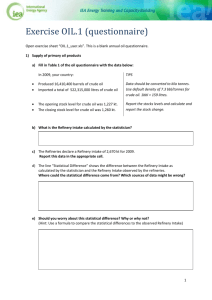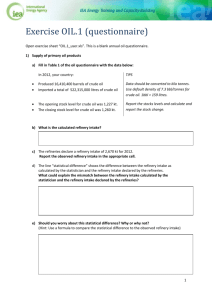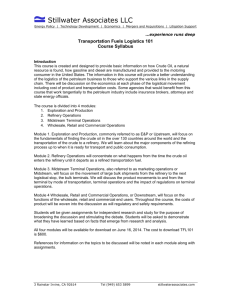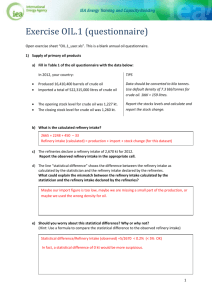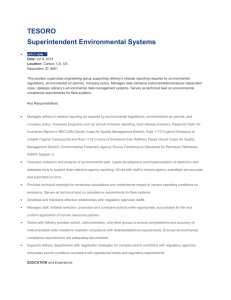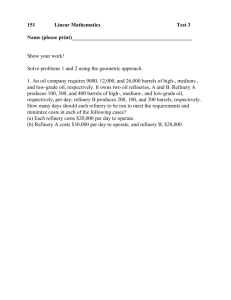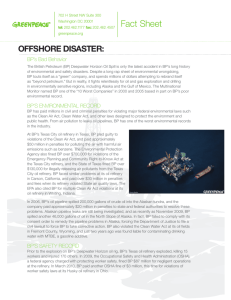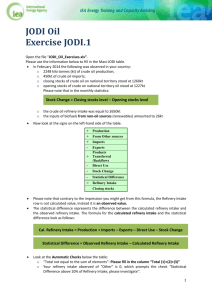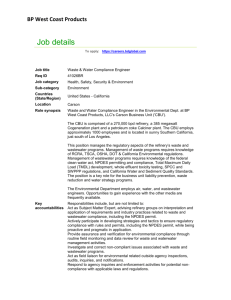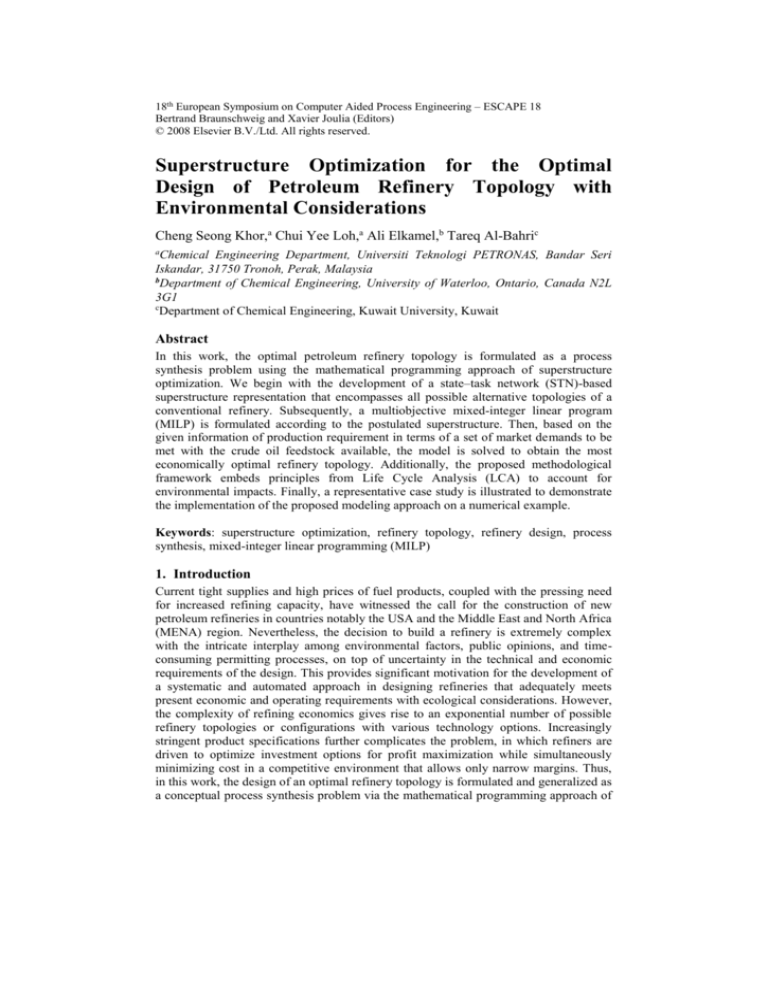
18th European Symposium on Computer Aided Process Engineering – ESCAPE 18
Bertrand Braunschweig and Xavier Joulia (Editors)
© 2008 Elsevier B.V./Ltd. All rights reserved.
Superstructure Optimization for the Optimal
Design of Petroleum Refinery Topology with
Environmental Considerations
Cheng Seong Khor,a Chui Yee Loh,a Ali Elkamel,b Tareq Al-Bahric
a
Chemical Engineering Department, Universiti Teknologi PETRONAS, Bandar Seri
Iskandar, 31750 Tronoh, Perak, Malaysia
b
Department of Chemical Engineering, University of Waterloo, Ontario, Canada N2L
3G1
c
Department of Chemical Engineering, Kuwait University, Kuwait
Abstract
In this work, the optimal petroleum refinery topology is formulated as a process
synthesis problem using the mathematical programming approach of superstructure
optimization. We begin with the development of a state–task network (STN)-based
superstructure representation that encompasses all possible alternative topologies of a
conventional refinery. Subsequently, a multiobjective mixed-integer linear program
(MILP) is formulated according to the postulated superstructure. Then, based on the
given information of production requirement in terms of a set of market demands to be
met with the crude oil feedstock available, the model is solved to obtain the most
economically optimal refinery topology. Additionally, the proposed methodological
framework embeds principles from Life Cycle Analysis (LCA) to account for
environmental impacts. Finally, a representative case study is illustrated to demonstrate
the implementation of the proposed modeling approach on a numerical example.
Keywords: superstructure optimization, refinery topology, refinery design, process
synthesis, mixed-integer linear programming (MILP)
1. Introduction
Current tight supplies and high prices of fuel products, coupled with the pressing need
for increased refining capacity, have witnessed the call for the construction of new
petroleum refineries in countries notably the USA and the Middle East and North Africa
(MENA) region. Nevertheless, the decision to build a refinery is extremely complex
with the intricate interplay among environmental factors, public opinions, and timeconsuming permitting processes, on top of uncertainty in the technical and economic
requirements of the design. This provides significant motivation for the development of
a systematic and automated approach in designing refineries that adequately meets
present economic and operating requirements with ecological considerations. However,
the complexity of refining economics gives rise to an exponential number of possible
refinery topologies or configurations with various technology options. Increasingly
stringent product specifications further complicates the problem, in which refiners are
driven to optimize investment options for profit maximization while simultaneously
minimizing cost in a competitive environment that allows only narrow margins. Thus,
in this work, the design of an optimal refinery topology is formulated and generalized as
a conceptual process synthesis problem via the mathematical programming approach of
2
A. Khor et al.
the structural optimization and parameter optimization of a process flowsheet
superstructure, also known as superstructure optimization.
2. Problem Statement and Research Objectives
We consider the following process synthesis problem of superstructure optimization of
the design of a petroleum refinery topology. Given the following information: (a) the
production requirements in terms of a set of refinery product demands (fixed amounts)
to be met; (b) available process units and the ranges of their capacities; (c) cost of crude
oil feed and the capital expenditure for process units; determine: (a) the optimal
topology or configuration of the refinery in terms of the selection and sequencing of the
states (materials streams) and tasks (process units); and (b) the (mass) flow rates of the
components in each stream.
3. Optimization Model Formulation
3.1. Step 1: Superstructure Representation of Refinery Topology Alternatives
Figure 1 depicts a state–task network (STN)-based superstructure representation that
includes many possible flowsheet alternatives of a typical refinery topology.
3.2. Step 2: General Solution Strategy for the Optimization Model
Since the model developed in this work is mainly linear in nature, a simultaneous
optimization strategy, as opposed to a sequential strategy, is implemented to yield an
optimal solution.
3.3. Step 3: Mathematical Programming Model for the Postulated Superstructure
3.3.1. Constraints of material balances
The overall and component material balances in the form of input–output of mass flow
rates are given by the following linear relations:
Ax = 0
(1)
where A is the matrix of linear constant yields obtained from Gary and Handwerk
(1994) and Kamiya (1991), and x is the decision variables vector of material flow rates.
The other sets of material balances are for the mixers and splitters, which model the
interconnections of the process units and are therefore, key modules for developing the
material balances. Constraints specifying the upper bound on the material flows and
production are also included.
3.3.2. Logical constraints
In this work, we employ the logical constraints in the way established by Raman and
Grossmann (1991, 1993) to assist in the modeling of the refinery topology. The logical
constraints play the following two roles:
to enforce certain design specifications on the selection of the process units and the
streams that are linking the units. These specifications are primarily based on
engineering knowledge as well as derived from past design experience;
to enforce structural specifications that stipulate interconnectivity relationships
among the nodes in the network that are made up of the states and the tasks. These
relationships describe the sequence in which the streams are linking the units.
3
A. Khor et al.
RGAS
C3–C4
PROCESSING POOL 2:
Naphtha
NAP
ADU
NHDT
/HDS
KERO
KHDT
/HDS
DIES
DHDT
/HDS
GSL
CREF
REF
ISO
ISO
SOLD
ASP
RFG
LPG
LPG
LSRN
1
HSRN
1
CR
BLND
RFG
NHDT
/HDS
KERO
T
LSRN
3
PROCESSING POOL 3: Vacuum Gas Oil
LSRN
2
FCCN
HSRN
2
GSL
FCCK
FCC1
FCCD
ARC1
ARDS
N
ARDS
K
ARC2
KERO
KERO
B
DSL
DIE
B
FCC
GO
HCRN
ARDS
ARDS
D
GSL
B
PROCESSING POOL 1:
Atmospheric Reduced
Crude (ARC) (Long
Residue)
HCR
ATK
HCRD
VRU
GOHDT
/HDS
VGO
Tasks
ADU
HDT/HDS
GO
MHC
N
VRC
MHC
GAS
MHC
K
LPG
MHC
D
PROCESSING POOL 4:
Vacuum Reduced
Crude (VRC)
H-OIL
NAP
GO
NAP
VGO
VIS
GO
Atmospheric Distillation Unit
Hydrotreater/Hydrodesulfurizer
(for N = naphtha, K = kerosene, D
= diesel, GO = gas oil)
BLND
CREF
ISO
SOLD
ARDS
Blending Unit
Catalytic Reformer
Isomerization Unit
Sold to customer
VRU
FCC
HCR
MHC
VIS
SDA
Vacuum Rerun Unit
Fluidized catalytic cracker
Hydrocracker
Mild hydrocracker
Visbreaker
Solvent deasphalter
States
RGAS
C3–C4
RFG
LPG
NAP
KERO
DIES
LSRN
HSRN
KERO T
ARC
VGO
GO
HCRN
ATK
HCRD
GSL B
Refinery gas
Propane & butane
Refinery fuel gas
Liquefied petroleum gas
Naphtha
Kerosene
Diesel
Light Straight Run Naphtha
Heavy Straight Run Naphtha
Treated kerosene
Atmospheric reduced crude
Vacuum gas oil
Gas oil
Naphtha from hydrocracker
Aviation turbine kerosene
Diesel from hydrocracker
ASP
DAO–LO
DAO–CR
COKE
RES
Asphalt
Deasphalted oil for lube oil
Deasphalted oil for cracking stock
Coke
Residue
Atmospheric Reduced
Desulfurization Unit
GAS
ASP
NAP
DAOLO
COK
GO
SDA
DAOCR
COKE
ASP
RES
Blended gasoline (also applies to
blended kerosene and diesel)
Figure 1. State–Task Network (STN)-based superstructure representation for a petroleum refinery
topology
18th European Symposium on Computer Aided Process Engineering – ESCAPE 18
Bertrand Braunschweig and Xavier Joulia (Editors)
© 2008 Elsevier B.V./Ltd. All rights reserved.
3.4. Environmental Performance Assessment for Risk Evaluation of Flowsheets
To incorporate environmental considerations in the proposed modeling framework, we
utilize the Life Cycle Analysis (LCA) approach proposed by Allen and Shonnard (2002)
that uses the Tier III performance assessment metrics for the environmental risk
evaluation of process flowsheets. The methodology aims to rank the available design
alternatives by performing their relative environmental risk assessment through
integrating the following aspects into the design: emissions estimation, environmental
fate and transport calculations, and environmental impact data and indicators.
In this work, we represent the refinery air emissions with a set of relative
environmental risk indices that measures the potential of global warming (GWP),
stratospheric ozone depletion (ODP), acid rain deposition/acidification (ARP), and
smog formation (SFP). Then, to estimate the index for a particular impact category that
is defined over the set I of all chemicals released from a process, we sum the
contributions for each chemical weighted by their emission rate, yielding:
IGWP,ODP,ARP,SFPDPRI
iI
Dimensionless Potential Risk Index DPRI i mi
(2)
in which the emission rate mi is given by the multiplication of the emission factor and
mass flow rate. The chemicals or pollutants i considered in this work are CO2, CO, SOx,
and NOx.
3.4.1. Objective function
Our goal is to determine the flowsheet of the optimal refinery network topology with
the minimum annualized cost and minimum environmental impacts. The objective
function involves a combination of: (1) minimizing the cost components that consist of
the capital investment cost for equipment (CCi), installation cost (ICi), raw material cost
(RMCi), and operating cost (OCi) associated with utility consumption (electricity,
cooling water, and steam); (2) maximizing revenues from the sales of the refined
products (Si); and (3) minimizing the environmental risk indices. Thus, the objective
function is expressed as:
min z
CC IC RMC OC S I
i
i
i
iI
i
i
GWP,i
I ODP,i I ARP,i ISFP,i (3)
iI pP
economic-based costs
environmental risk indices
4. The Role of Logic Propositions and Logical Constraints in Modeling
Qualitative Information of Refinery Process Flow
The major process flows in a refinery network is discussed in this section, with an
emphasis on formulating the logical constraints that model the related qualitative
information, by utilizing the power afforded by propositional logics and binary 0–1
variables. A binary variable yi with the value of one indicates that a process unit (or
material stream) represented by the subscript term i is selected in the optimal topology
solution; a value of zero indicates otherwise.
4.1. Processing Pool 1: Alternatives for Atmospheric Reduced Crude (ARC)
The crude oil from the storage tank is heated in a furnace and then charged to an
atmospheric crude distillation unit (ADU), which is a mainstay feature of an oil refining
scheme as the primary fractionation function of the crude oil according to different
boiling point ranges. ADU separates the crudes into butanes and lighter wet gas,
unstabilized light naphtha, heavy naphtha, kerosene, atmospheric gas oil, and
Superstructure Optimization for the Optimal Design of Petroleum Refinery Topology
with Environmental Considerations
5
atmospheric topped or reduced crude (ARC). In older refineries especially those that
typically handle low sulfur crudes, the topped crude is sent to the vacuum distillation
unit (VDU) for separation into vacuum gas oil (VGO) and vacuum reduced crude
(VRC) bottoms. However, modern refineries with high technology capable of
processing crudes with high sulfur content typically employ an atmospheric residuum
desulfurization unit (ARDS) for sulfur removal from the crude oil. Therefore, two
design alternatives exist for ARC from ADU: (1) it is sent to the ARDS for sulfur
removal to produce VRC that is then sent to the VDU; (2) it is sent directly to the VDU
to produce VGO and VRC, with the VGO subsequently hydrotreated in a unit denoted
as GOHDT.
If ARDS is selected, then VDU must be selected but without GOHDT being
selected; thus, the constraint to be enforced in the optimization model is:
yARDS ≤ yVDU
(1)
If ARDS is not selected, then both VDU and GOHDT must be selected, with the
corresponding constraint given by:
yVDU ≤ yGOHDT
(2)
4.2. Processing Pool 2: Alternatives for Naphtha Exiting Hydrotreater
(HDT)/Hydrodesulfurizer (HDS)
The following three alternatives are available for the full-range naphtha leaving ADU:
(1) it is treated for sulfur removal via the hydrotreater (HDT) or hydrodesulfurizer
(HDS); (2) its subcomponent of the LSRN stream from the top of the distillation
column is sent to a gasoline blending pool; (3) it is directly sold (in its existing form).
Therefore, the corresponding constraint is:
yHDS/HDT + yBLEND + ySOLD ≥ 1
(3)
For the stream exiting the HDT, two alternatives are possible: (1) it is used as the
blending stocks for gasoline and jet fuel (mainly) or for diesel (BLEND); or (2) it is
utilized as a feedstock for the catalytic reformer (REF) and/or the isomerization unit
(ISO). The corresponding constraint enforcing that at least one of these two alternatives
must be selected is given by:
yBLEND + yREF + yISO ≥ 1
(4)
4.3. Processing Pool 3: Alternatives for Vacuum Gas Oil (VGO) Processing
The VGO stream is fed to either the fluidized catalytic cracker (FCC) or the
hydrocracker (HCR) following hydrotreatment in GOHDT. Both FCC and HCR convert
heavy gas oils into lighter products that are subsequently utilized as blendstocks for
gasoline and diesel fuels. Hence, in general practice, both units do not coexist in a single
site especially for relatively low-to-medium crude oil throughput unless the economies
of scale as dictated by a high throughput justifies the routing of the hydrotreated VGO
to be split into two streams, each for FCC and HCR. Nevertheless, in principle, both
units can coexist, with HCR usually favoured over FCC and is thus relatively more
common, particularly in large-scale refineries that typically handles high crude oil
throughput. Therefore, the constraint that allows at least one of these units to be selected
is as follows:
yFCC + yHCR ≥ 1
(5)
6
A. Khor et al.
4.4. Processing Pool 4: Alternatives for Vacuum Residue or Vacuum Reduced Crude
(VRC) Processing and Upgrading
Depending on the crude oil type and the related process economics, VRC is further
processed for production of transportation fuels (i.e., gasoline, kerosene, and diesel),
typically via one of the following intermediary process units: visbreaker (VIS), solvent
deasphalter (SDA), or mild hydrocracker (M-HCR). The corresponding constraint is to
select none (the provision for this option is the selection of an H-Oil unit, which is
introduced later) or at most one unit among these three options, as expressed by:
yVIS + ySDA + yM-HCR ≤ 1
(6)
If none of the intermediate units or the delayed coker (COK) is selected, VRC is then
sent directly to the H-Oil unit (Kamiya, 1991, pp. 61–62). Since both COK and H-Oil
completely convert their feed material to extinction (100% conversion), they are not
used in the presence of one another or other process units. Thus, the constraint that
selects exactly one of either these two units is enforced:
yCOK + yH-OIL = 1
(7)
5. Numerical Example
We demonstrate the implementation of the proposed modeling approach on a small
example using GAMS/CPLEX. The capital and operating cost of process units are
obtained from Maples (1993) and adjusted to the second quarter of year 2007 using the
Marshall & Swift equipment cost index for petroleum products (Chemical Engineering,
2007); as well, all monetary figures are adjusted to the rate of USD in year 2007. The
main purpose of presenting this numerical example is to demonstrate that if an
aggregated model is developed by keeping it as linear as possible and with a minimum
amount of use of binary variables adopted, then the model can likely be solved by
employing a simultaneous optimization strategy. Figure 2 shows the obtained optimal
solution of the refinery topology.
6. Conclusions
This ongoing work presents a superstructure optimization approach for synthesizing an
oil refinery topology using an aggregated model at a high level of abstraction, which is
equivalently intended for high-level business decision-making. We are currently
extending the model to enable the real-world practical capability of processing multiple
types of crude oils. Additionally, we are also incorporating the more representative
nonlinear models for the process units in order to capture their inherent complexity,
which includes considering nonlinear blending equations and mixing properties.
Superstructure Optimization for the Optimal Design of Petroleum Refinery Topology
with Environmental Considerations
7
Refinery Gas (RG)
RG
Liquefied Petroleum Gas (LPG)
LPG
Light Straight-Run Naphtha (LSRN)
Naphtha
Isomerization
(ISO)
Heavy Straight-Run
Naphtha (HSRN)
Catalytic
Reforming (CREF)
Kerosene
Kerosene
Diesel
RG
Atmospheric
Reduced
Crude (ARC)
Vacuum Rerun
Unit (VRU)
Gasoline
Hydrotreating (HDT)/
Hydrodesulfurization
Fluid Catalytic
Cracking (FCC)
Vacuum
Gas Oil (VGO)
Hydrotreating/
Hydrodesulfurization
Diesel
LPG
Cracked Naphtha
Cycle Gas Oil (CGO)
Naphtha
Gas Oil
(GO)
Hydrocracking
(HCR)
Vacuum
Reduced
Crude
(VRC)
ATK
Diesel
Aviation
Turbine
Kerosene
(ATK)
Naphtha
Mild
Hydrocracker (MHC)
Kerosene
Diesel
RG
LPG
H-Oil
Naphtha
GO
VGO
Figure 2. Optimal refinery topology for the numerical example
References
Chemical Engineering, September 2007, Marshall & Swift Equipment Cost Index,
Available online: http://www.che.com.
J. H. Gary and G. E. Handwerk, 1994, Petroleum Refining: Technology and Economics,
3rd Edition, New York, Marcel Dekker.
Y. Kamiya (ed.), 1991, RAROP Heavy Oil Processing Handbook. Japan, Research
Association for Residual Oil Processing.
R. E. Maples, 1993, Petroleum Refinery Process Economics, Tulsa, Oklahoma:
PennWell Publishing Company.
R. Raman and I. E. Grossmann, 1991, Relation between MILP modelling and logical
inference for chemical process synthesis, Comp. Chem. Eng., 15, 2, 73–84.
R. Raman and I. E. Grossmann, 1993, Symbolic integration of logic in mixed-integer
linear programming techniques for process synthesis, Comp. Chem. Eng., 17, 9, 909–
927.

